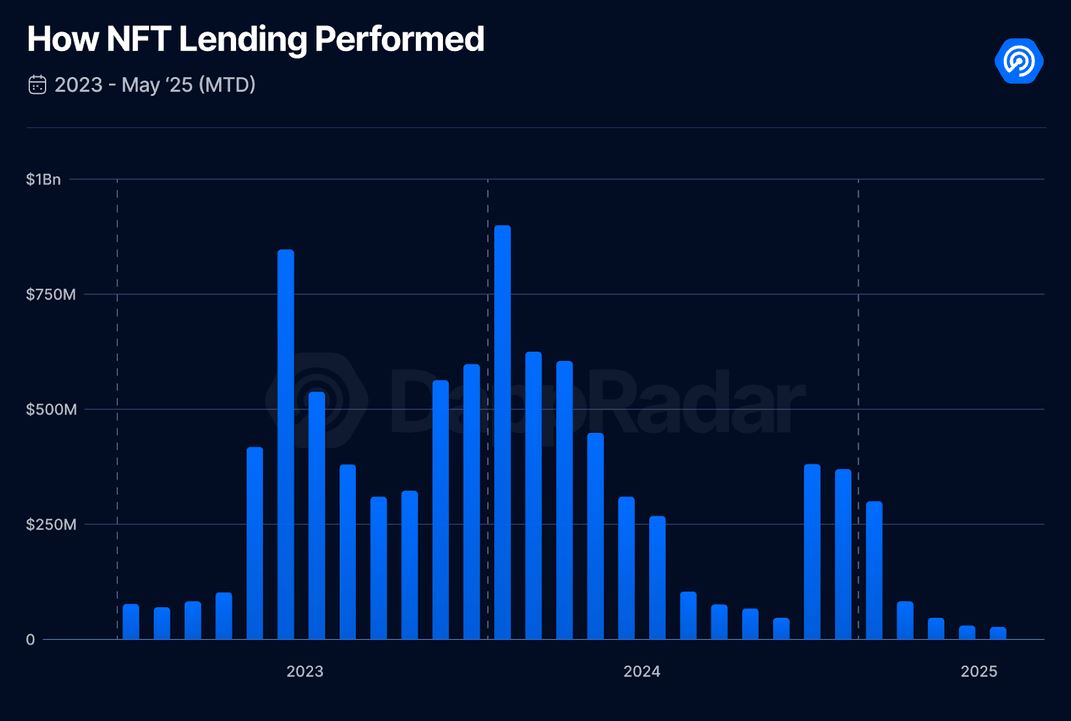The Non-Fungible Token (NFT) lending market is facing challenges with a sharp decline in trading volumes and user engagement. According to blockchain analytics platform DappRadar, integrating real-world assets (RWAs) with NFTs presents a key opportunity to revitalize the struggling sector.
Current State of NFT Lending:
The NFT lending market, which allows NFT holders to borrow funds using their tokens as collateral, has experienced a substantial downturn. Volumes have plummeted by 97%, dropping from approximately $1 billion in January 2024 to $50 million in May, as reported by DappRadar analyst Sara Gherghelas.
Catalysts for Revival:
Gherghelas suggests that for NFT lending to recover, it requires “new catalysts.” Among these, the integration of real-world asset NFTs, such as tokenized real estate or yield-bearing assets, could provide more stable and reliable collateral sources.
Challenges Faced:
As of 2025, the NFT lending market has not found a compelling reason to rebound. The infrastructure remains, and platforms are still active, but overall activity has slowed. The sector is in a holding pattern, awaiting either a market recovery or a new use case to spark renewed interest.

Additional Catalysts for Rekindling NFT Lending:
- Improved Lending Tools: Tools that simplify the borrowing process for NFT holders.
- Smart Infrastructure: Protocols should focus on creating “smart infrastructure” such as undercollateralized loans, credit scores, and AI-driven risk matching.
Decline in Borrower Activity:
Since January of the previous year, borrower activity has decreased by 90%, and the number of lenders has fallen by 78%.
Average NFT Loan Size:
The average NFT loan size has also decreased significantly, from a peak of $22,000 in 2022 to $4,000 in May, representing a 71% year-over-year decrease. This indicates that users are either borrowing against lower-value assets or becoming more cautious with leverage.

Loan Duration:
The average loan duration has also shortened. After averaging about 40 days in 2023, it has decreased to 31 days and remained stable throughout 2024 and into 2025. This suggests that loans are being taken more frequently but for shorter periods, potentially indicating more tactical liquidity plays.
Impact of Overall NFT Market Downturn:
The decline in NFT lending is also linked to the broader NFT market downturn, which saw volumes decrease by 61% in the first quarter, from $4.1 billion a year ago to $1.5 billion.
Collateral Value Collapse:
According to Gherghelas, “With collateral value collapsing, the lending activity naturally followed.”
Narrowed Protocol Landscape:
The number of active NFT lending applications is limited, with only eight protocols holding any significant market share.
Shifting Focus:
The “flip-for-liquidity” model that thrived during bull markets is not sustainable in a quieter, more risk-averse environment. NFT lending is shifting its focus, with platforms diversifying, use cases evolving, and collateral preferences changing.
Potential for a Second Wind:
If the next phase of NFT lending builds on utility, culture, and better design, it may find a second wind and create a more sustainable model.
Key Takeaways:
- NFT lending volumes have significantly declined.
- Integrating real-world assets (RWAs) could revitalize the sector.
- Improved lending tools and smart infrastructure are needed.
- The overall NFT market downturn has contributed to the decline.
- A shift towards utility and better design is crucial for the future of NFT lending.